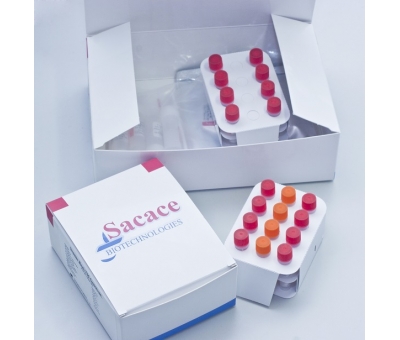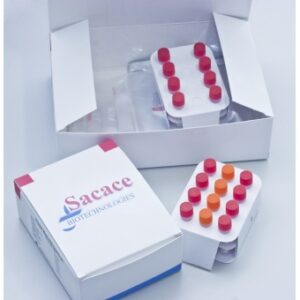Subtotal: EGP 19,656.00
Gardnerella vaginalis/Lactobac. species Real-TM Quant with silica DNA extraction kit 100 tests
Available on backorder
Expiry Date
Real Time PCR test for quantitative detection of G.vaginalis and Lactobacillus
EGP 19,810.46 EGP 24,763.08
Available on backorder
Bacterial vaginosis (BV) is considered to be the most common cause of vaginal inflammation among both pregnant and non-pregnant women and prevalences between 4.9% and 36.0% have been reported from European and American studies. It previously was called nonspecific vaginitis or Gardnerella-associated vaginitis.
The adult human vagina is a complex ecosystem containing an abundance of microorganisms. In women of childbearing age this system is dominated by Lactobacillus spp., a genus of gram-positive, non-motile rod-like bacteria, a defining characteristic of which is the ability to grow in acid media and tolerate acid conditions (pH <4.5); lactobacilli also ferment carbohydrates to produce lactic acid and produce H2O2 which provides a natural defense against Gardnerella vaginalis. In bacterial vaginosis (BV) the balance of flora is changed with reduced numbers of lactobacilli (normal concentration 10^6-10^10 CFU/ml) and an increase in numbers of other facultative and anaerobic species such as anaerobic cocci Prevotella spp., Gardnerella vaginalis, and Mobiluncus spp. (normal concentration < 10^3-10^5 CFU/ml). G. vaginalis is virtually always present at high concentrations in women who have BV but is also detected frequently in normal women and in some cases the concentration of Gardnerella vaginalis can reach 10^7-10^8 CFU/ml also in absence of BV, so the most important maker of BV is the ratio of logarithm concentration Lactobacillus spp and G. vaginalis.
The clinical significance of studying vaginal flora is that it helps determine the quantity of microorganisms and assess the ratio between the different groups of conditionally pathogenic microorganisms and the normal flora.
The total quantity of bacteria serves as an indicator of infection level in the vaginal enviroment: under normal conditions it can vary between 10^6 and 10^9 (6-9 Log). The ratio between lactobacilli and the total bacterial quantity can be used as an indicator of the balance between the normal and conditionally pathogenic flora: the normal proportion of lactobacilli should be 95 to 100% of the total bacterial quantity.
Bacterial Vaginosis Real-TM Quant kit is for the quantitative detection of Gardnerella vaginalis, Atopobium vaginae, Lactobacillus spp. and total bacteriae quantity in the vaginal biotope. The logarithmic ratio between Lactobacillus spp. and the total quantity of bacteriae and also between Lactobacillus spp. and facultative pathogen microorganisms (Gardnerella vaginalis and Atopobium vaginae) allows to detect with high precision bacterial vaginosis disease related to normal vaginal microflora suppression (Lactobacillus spp.) and substitution with facultative pathogen microorganisms (Gardnerella vaginalis and Atopobium vaginae). The use of Bacterial Vaginosis Real-TM Quant kit allows to monitor vaginal environment condition and to check the therapy efficiency.
Based on 0 reviews
Be the first to review “Gardnerella vaginalis/Lactobac. species Real-TM Quant with silica DNA extraction kit 100 tests”
Shipping Policy
Payment & Delivery:
- You agree to provide valid shipping address, Email address and phone numbers, if we received false information, we are not responsible to any action happen to the product delivered.
- Delivery period may be not known as each item has its own delivery period as well as the seller delivery terms are not the same, so we don't share exact delivery period before we get confirmed information concerning this part, you don't need to confirm your order before receiving such information.
- Some items will have certain Expiry dates, if this information is available on the item, we will share it, if not, please request the expiry date after adding the item to the cart.
- Some items have expiry date that you don't satisfied with, So Please request new expiry date to the same item.
- When placing an order, you will confirm your personal information, shipping and billing address, payment methods, and the subtotal amount of the order.
- You will receive an email confirming your order with your order number, if you wish to contact support you will need to use the specific order number.
- Payment methods are the following:
A- Online payment with credit card (we accept Visa and MasterCard )
B-Cash Upon Delivery
C- Bank deposit in our bank account
- You agree to provide valid and accurate payment information.
Refund Policy
- The buyer has the full rights to return products that are shipped from BGENZ.com.
Cancellation / Return / Exchange Policy
Return Policy:
- The buyer has the full rights to return products that are shipped from BGENZ.com.
- Products can be returned within 14 days of receipt of shipment in most cases.
- Some products have different policies or requirements associated with them.
- Some kits or reagents will need technical report with pictures showing the defect or malfunction.
- You have the right to choose to replace the product or refund your money.
General Inquiries
There are no inquiries yet.



 Human VEGF ELISA Kit- 96 Tests
Human VEGF ELISA Kit- 96 Tests 


There are no reviews yet.